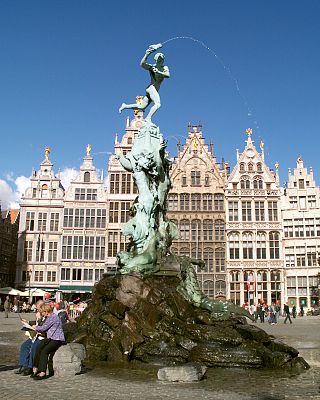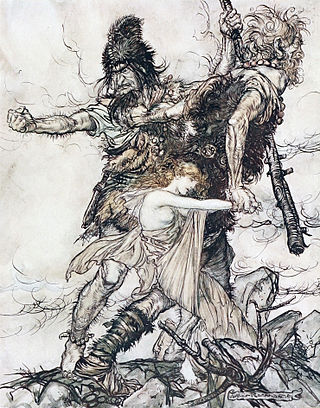
In folklore, giants are beings of humanoid appearance, but are at times prodigious in size and strength or bear an otherwise notable appearance. The word giant is first attested in 1297 from Robert of Gloucester's chronicle. It is derived from the Gigantes of Greek mythology.

Het Steen is a medieval fortress in the old city centre of Antwerp, Belgium, one of Europe's biggest ports. The surviving structure was built between 1200 and 1225 as a gateway to a larger castle of the Dukes of Brabant which was demolished in the 19th century. As the first stone fortification of Antwerp, Het Steen is Antwerp's oldest building and used to be part of its oldest urban centre. The words "Het Steen", translated from Dutch mean "the rock" in English, although that is not the equivalent ethymological meaning.

Abraham Janssens I, Abraham Janssen I or Abraham Janssens van Nuyssen (1575–1632) was a Flemish painter, who is known principally for his large religious and mythological works, which show the influence of Caravaggio. He was the leading history painter in Flanders prior to the return of Rubens from Italy.
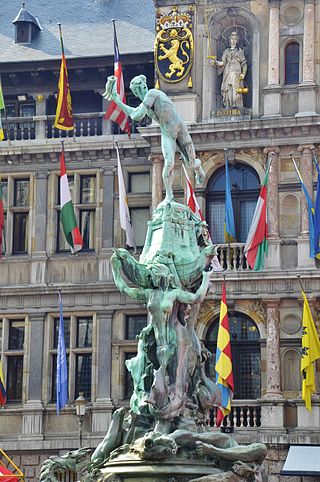
Silvius Brabo was a mythical Roman soldier and the legendary founder and namesake of the city of Antwerp and Duke of Brabant.

Antwerp International Airport, commonly known simply as Antwerp Airport, is a small international airport located 2.9 nautical miles south of Antwerp, Belgium. The airport is used for some scheduled and charter flights, as well as business and general aviation, and served 239,517 passengers in 2022.

Folklore of the Low Countries, often just referred to as Dutch folklore, includes the epics, legends, fairy tales and oral traditions of the people of Belgium, Netherlands and Luxembourg. Traditionally this folklore is written or spoken in Dutch or in one of the regional languages of these countries.

Ommegang or Ommeganck is the generic name for various medieval pageants celebrated in the Low Countries.
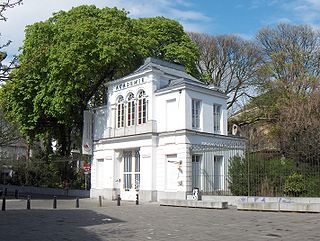
The Royal Academy of Fine Arts Antwerp is an art academy located in Antwerp, Belgium. It is one of the oldest of its kind in Europe. It was founded in 1663 by David Teniers the Younger, painter to the Archduke Leopold Wilhelm and Don Juan of Austria. Teniers was master of the Guild of St Luke—which embraced arts and some handicrafts—and petitioned Philip IV of Spain, then master of the Spanish Netherlands, to grant a royal charter to establish a Fine Arts Academy in Antwerp. It houses the Antwerp Fashion Academy.
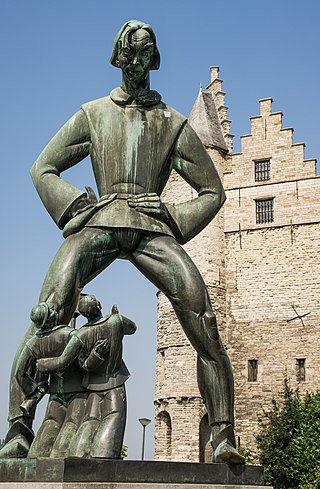
Lange Wapper is a Flemish folkloric character. He is a legendary giant and trickster whose folk tales were told especially in the city of Antwerp and its neighbouring towns, but similar tales are also prominent in other Flemish cities.

The Antwerp Water Works (Dutch: Antwerpse Water Werken) or AWW produces water for the city of Antwerp (Belgium) and its surroundings. The AWW has a yearly production of 150,000,000 m3 (5.3×109 cu ft) and a revenue of 100 million euro.

Antwerp Giants, named Telenet Giants Antwerp for sponsorship reasons, is a Belgian professional basketball club based in Antwerp. Their home arena is Lotto Arena. The club plays in the BNXT League, the highest tier of Belgian basketball. The club was created from the merger of Sobabee and Racing Mechelen. Then named Racing Basket Antwerpen, it was renamed Antwerp Giants in 2005.
The Division of Honour is the highest level of women's volleyball in Belgium.

Antwerp is the largest city in Belgium by area at 204.51 km2 (78.96 sq mi) and the capital of Antwerp Province in the Flemish Region. With a population of 536,079, it is the most populous municipality in Belgium, and with a metropolitan population of around 1,200,000 people, it is the second-largest metropolitan region in Belgium, second only to Brussels.
The following is a timeline of the history of the municipality of Antwerp, Belgium.
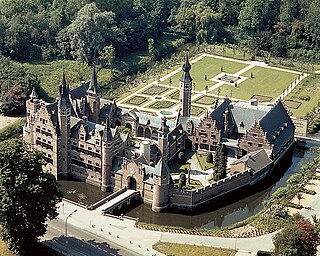
The Sterckshof castle is in Deurne, Antwerp, Belgium. From 1994 to 2014 it housed the Sterckshof silver museum of the Province of Antwerp. Built on the site of a much older castle, or great house, the present building is a reconstruction erected in the 1920s.

The Grote Markt is the central square of Antwerp, Belgium, situated in the heart of the old city quarter. It is surrounded by the city's Renaissance Town Hall, as well as numerous guildhalls with elaborate façades, the majority of which are reconstructions in the 19th and early 20th century, approximating paintings of the square by Flemish artists. A few of the guildhall façades, such as that of Sint-Joris's are intact originals entirely dating back to the 16th century.
Antwerpse Basketball Club was a professional basketball club based in the city of Antwerp, Belgium.
Tram route 1 is a tram route in Antwerp (Belgium) connecting the Bolivarplaats in the Zuid neighborhood with the Havana site in the Luchtbal neighborhood to the North via the Leien and Noorderlaan.

Michiel Hillen van Hoochstraten or Michel Hillenius, was a Flemish printer, publisher, bookseller and bookbinder. His printing press put out publications in a wide range of genres, including imperial ordinances, almanacs, devotional literature, anthologies of customs, textbooks, etc. He also printed humanistic writings by Erasmus, Adrianus Barlandus and Jacobus Latomus as well as the first Dutch-language version of the story of Till Eulenspiegel. His multiple editions of the Bible in Dutch translation were among the first to be published. Michiel Hillen van Hoochstraten is regarded as the most important publisher active in Antwerp in the first half of the sixteenth century.















